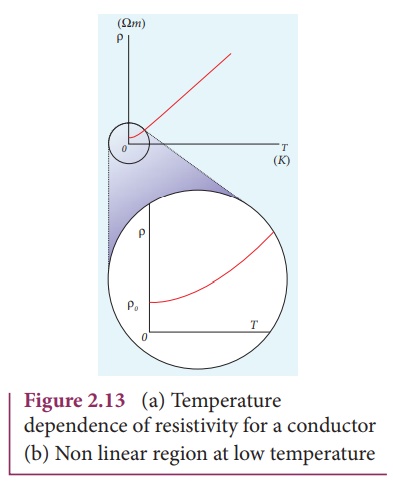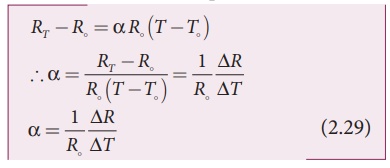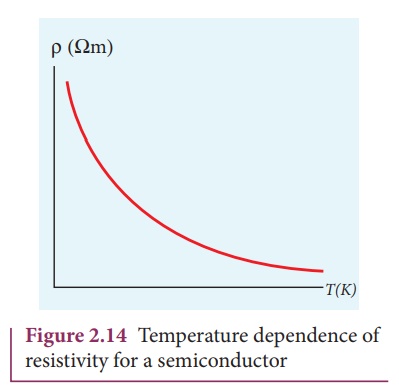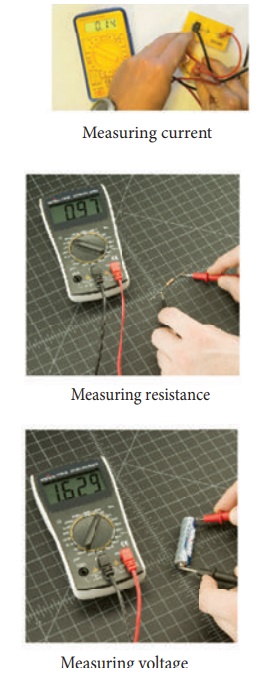Explanation, Formulas, Solved Example Problems - Temperature dependence of resistivity | 12th Physics : Current Electricity
Chapter: 12th Physics : Current Electricity
Temperature dependence of resistivity
Temperature dependence of resistivity
The resistivity of a material is dependent on temperature. It is experimentally found that for a wide range of temperatures, the resistivity of a conductor increases with increase in temperature according to the expression,

where ŽüT is the resistivity of a conductor at T oC, Žüo is the resistivity of the conductor at some reference temperature T┬║ (usually at 20┬║C) and ╬▒ is the temperature coefficient of resistivity. It is defined as the ratio of increase in resistivity per degree rise in temperature to its resistivity at T┬║.
From the equation (2.27), we can write

where ŌłåŽü = ŽüT ŌĆō Žüo is change in resistivity for a change in temperature ŌłåT = T ŌĆō To. Its unit is per oC.
╬▒ of conductors
For conductors ╬▒ is positive. If the temperature of a conductor increases, the average kinetic energy of electrons in the conductor increases. This results in more frequent collisions and hence the resistivity increases. The graph of the equation (2.27) is shown in Figure 2.13
Even though, the resistivity of conductors like metals varies linearly for wide range of temperatures, there also exists a non-linear region at very low temperatures. The resistivity approaches some finite value as the temperature approaches absolute zero as shown in Figure 2.13(b).
As the resistance is directly proportional to resistivity of the material, we can also write the resistance of a conductor at temperature T ┬║C as


The temperature coefficient can be also be obtained from the equation (2.28),

where R = RT ŌłÆR is change in resistance during the change in temperature ╬öT = T ŌĆōT
╬▒ of of semiconductors
For semiconductors, the resistivity decreases with increase in temperature. As the temperature increases, more electrons will be liberated from their atoms (Refer unit 9 for conduction in semi conductors). Hence the current increases and therefore the resistivity decreases as shown in Figure 2.14. A semiconductor with a negative temperature coefficient of resistance is called a thermistor.
The typical values of temperature coefficients of various materials are given in table 2.3.


We can understand the temperature dependence of resistivity in the following way. In section 2.1.3, we have shown thatthe electrical conductivity, Žā = ne2Žä / m . As the m resistivity is inverse of Žā, it can be written as,

The resistivity of materials is
i) inversely proportional to the number density (n) of the electrons
ii) inversely proportional to the average time between the collisions (Žä).
In metals, if the temperature increases, the average time between the collision (Žä) decreases and n is independent of temperature. In semiconductors when temperature increases, n increases and Žä decreases, but increase in n is dominant than decreasing Žä, so that overall resistivity decreases.

EXAMPLE 2.13
If the resistance of coil is 3 ╬® at 20 0C and ╬▒ = 0.004/0C then determine its resistance at 100 0C.
Solution
R0= 3 ╬®,ŌĆā T = 100┬║C,ŌĆā T0 = 20┬║C
╬▒ = 0.004/┬║C,ŌĆā RT = ?
RT= R0(1 + ╬▒(T-T0))
R100 = 3(1 + 0.004 ├Ś 80)
R100 = 3(1 + 0.32)
R100 = 3(1.32)
R100 = 3.96 ╬®
EXAMPLE 2.14
Resistance of a material at 10┬║C and 40┬║C are 45 ╬® and 85 ╬® respectively. Find its temperature co-efficient of resistance.
Solution
T0 = 10┬║C, T = 40┬║C, R0= 45 ╬® , R = 85 ╬®
α = 1/R . ΔR /ΔT

╬▒ = 0.0296 per ┬║C
Related Topics